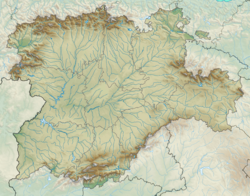Béjar (Spanish pronunciation: [ˈbexaɾ]) is a town and municipality of Spain located in the province of Salamanca, autonomous community of Castile and León. As of 2018, it had a population of 12,961. The historical development of the town has been linked to its once thriving textile manufacturing industry.
Béjar | |
|---|---|
 | |
| Coordinates: 40°23′N 5°46′W / 40.383°N 5.767°W | |
| Country | Spain |
| Autonomous community | Castile and León |
| Province | Salamanca |
| Area | |
• Total | 46 km2 (18 sq mi) |
| Elevation | 959 m (3,146 ft) |
| Population (2018)[2] | |
• Total | 12,961 |
| • Density | 280/km2 (730/sq mi) |
| Demonym | bejarano |
| Time zone | UTC+1 (CET) |
| • Summer (DST) | UTC+2 (CEST) |
| Postal code | 37700 |
| Dialing code | 923 |
| Website | www |
History
editBéjar was founded towards October–November 1208 and it was presumably granted a fuero afterwards.[3] It was originally placed to the south of the current settlement, but the population relocated to its current location in the first half of the 14th century.[3] Featuring a cattle-based economy, the town sustained a quick early growth.[3] Over the rest of the middle ages, the town passed several times from a royal demesne to seigneurial lordship and vice versa.[3] The town saw its fuero ratified in 1333.[3] Béjar celebrated an eight-day long medieval fair every year.[4] The town enjoyed from availability to plenty of wood resources, hydropower and sheep flocks.[5]
The arrival to power of the Zúñiga family after 1396 favoured the installment of numerous courtiers and servants, who increased the demand for clothing products.[6] Cloth-making boomed in the late-17th century.[7] The Ducal House of Béjar brought Flemish artisans to update the wool manufacturing techniques.[8]
Unlike other textile manufacturing hubs in the Castilian Meseta, the local textile industry got to survive past the Early Modern Period.[9] The late modern history of Béjar is indeed marked by its thriving textile industry, and during the 19th century it came to be referred to as the "Castilian Manchester".[10]
Due to the peripheral location of the town and the rugged relief, railway arrived late to Béjar, in 1894.[11] Following the end of the Civil War, Béjar became a major provider of wool clothes, primarily used for military and civil servants' uniforms.[12]
Béjar maintained a positive demographic growth until 1970, peaking at 17,576 inhabitants.[12] The textile industry entered a crisis in the 1970s, prompting to staffing cutbacks.[12] Passenger train services in the Astorga–Plasencia line closed on 1 January 1985, and rail freight transport a decade later, worsening rural flight patterns in the area and hindering business development.[13] In the wake of the decline of the secondary sector, the municipality has tried to foster other alternatives for the local economy such as tourism.[14]
Name
editThe name Béjar is presumably of pre-Roman origin and it has been documented as Biclara and Biclaro.[15]
Monuments
editBéjar has many remarkable monuments and historical buildings:[16]
- City walls: well-preserved medieval fort
- Church of Saint James (Santiago): built in the 12th century, now serves as a Museum of Religious Art
- Church of Saint Mary the Great (Santa María la Mayor): built between the 12th and 17th centuries, in several different architectural styles (from Mudejar to Baroque)
- Jewish Museum David Melul: shows Béjar's Hebrew past
- Ducal Palace and Camera Obscura: an ancient fortress transformed into a palace for the Duke and Duchess of Béjar in the 16th century.
See also
editReferences
edit- Citations
- ^ a b "Municipio:Béjar". www.lasalina.es (in Spanish). Retrieved 2017-10-28.
- ^ Municipal Register of Spain 2018. National Statistics Institute.
- ^ a b c d e Lora Serrano 1986, p. 272.
- ^ Lora Serrano 1986, p. 276.
- ^ Domínguez Garrido 2019, pp. 442–443, 458.
- ^ Domínguez Garrido 2019, pp. 443–444.
- ^ Domínguez Garrido 2019, p. 449.
- ^ Domínguez Garrido 2019, p. 450.
- ^ Domínguez Garrido 2019, p. 435.
- ^ Hernández Díaz 2013, p. 24.
- ^ Muñoz Domínguez 2013, pp. 315, 325.
- ^ a b c Brossmann 2007, p. 10.
- ^ "36 años sin tren en el sureste salmantino". Gaceta de Salamanca. 6 January 2021.
- ^ Brossmann 2007, p. 7.
- ^ García Sánchez 2004.
- ^ "Conoce Béjar – Excmo. Ayuntamiento de Béjar" (in European Spanish). Retrieved 2019-01-22.
- Bibliography
- Brossmann, Michael (2007). "El análisis del sector turístico en Béjar como caso de estudio de las nuevas políticas urbanas en las pequeñas ciudades" (PDF). Polígonos: Revista de Geografía (17). León: Universidad de León: 7–31. ISSN 1132-1202.
- Domínguez Garrido, Urbano (2019). "Manufacturas laneras en Béjar durante la Edad Moderna. La formación de un paisaje industrial: Caracterización y protección". Studia Historica. Historia Moderna. 41 (1). Salamanca: Ediciones Universidad de Salamanca: 435–484. doi:10.14201/shhmo2019411435484. hdl:10366/142070. ISSN 0213-2079.
- García Sánchez, Jairo J. (12 July 2004). "Castilla y León y sus topónimos (II)". Rinconete. ISSN 1885-5008 – via Centro Virtual Cervantes.
- Hernández Díaz, José María (2013). "La historia contemporánea de Béjar" (PDF). Historia de Béjar. Vol. 2. pp. 19–26. ISBN 978-84-7797-416-1.
- Lora Serrano, Gloria (1986). "La feria de Béjar en el siglo XV" (PDF). Anales de la Universidad de Alicante. Historia Medieval (4–5). San Vicente del Raspeig: Universidad de Alicante. doi:10.14198/medieval.1986.4-5.15. ISSN 2695-9747.
- Muñoz Domínguez, José (2013). "Huellas actuales de la historia contemporánea de Béjar (1777-2012)" (PDF). Historia de Béjar. Vol. 2. pp. 299–351. ISBN 978-84-7797-416-1.
External links
edit- i-Béjar web portal (in Spanish)


